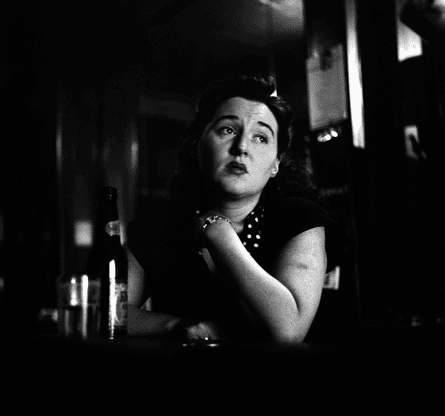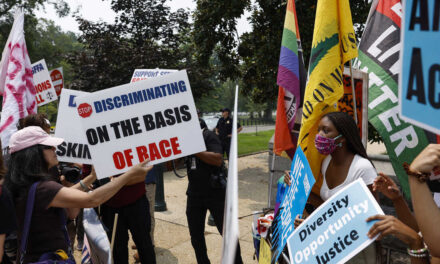From Marilyn Monroe flaked out in an armchair, resting her swollen feet, to Richard Burton and Elizabeth Taylor sitting in a pub with a pound of sausages, Eve Arnold’s photographs are knitted into the celebrity mythology of the 20th century. They showed even those who had no idea who the photographer was that it was hard work being Marilyn, and that Hollywood’s starriest couple weren’t strangers to a fry-up after a night on the booze.
Decades after the deaths of their subjects, these pictures are enriched by the histories that stand between them and us. They read like the warnings of a benign clairvoyant. Arnold herself died in 2012, weeks before her 100th birthday. The quality that shines out from this luminous career retrospective is just how totally her subjects trusted her with the backstage of their lives.
Joan Crawford’s ageing skin is captured in the unforgiving closeup of a makeup mirror as she prepares to smear on her eyes; Marlene Dietrich pulls a bemused face in a recording session; Vanessa Redgrave presents her bare bum as she hoicks up a heavy white stocking in preparation for becoming Anne Boleyn in the film of A Man for All Seasons.

For all that she became the photographer of choice for many stars, Arnold’s portraiture was never just about celebrity. It was about image construction as a necessity of survival among her predominantly female subjects. The Redgrave picture echoes one from the start of Arnold’s career, when she subverted a student assignment to shoot a fashion show into a study of a previously undocumented Harlem scene, where black women in skin-whitening makeup modelled homemade frocks.
The composition of the two pictures – taken 10 years apart – is so strikingly similar that they could not have been coincidental: both women are captured at their most vulnerable, slightly off balance, with suspender belts dangling limply over their buttocks as they haul their clothing into place; both are preparing to step out as queens. A famous studio back shot of Monroe, coquettishly clutching a sheet to her naked body, is likewise mirrored by an apparently impromptu snap of her fixing her hair in a grotty airport washroom, with her dress bunched up around her waist.
The show takes its cue from a quote from Arnold: “I have been poor and I wanted to document poverty; I had lost a child and I was obsessed with birth; I was interested in politics and I wanted to know how it affected our lives; I am a woman and I wanted to know about women.” Set across three rambling floors of a Georgian townhouse and coaching annexe in the self-consciously picturesque Sussex town of Petworth, it uses the space well to tell the episodic story of a pioneering photographer. The first woman to be admitted to the Magnum photographic agency, Arnold moved from moody social documentary to glamorous travel journalism, via myth-making for Hollywood, Washington DC and London.
A multiple-location shoot of Monroe during filming of The Misfits slinks along the walls of the first-floor salon, a floor above the Harlem pictures. In a section of First Lady pictures, all taken in 1960, Jacqueline Kennedy and her small daughter Caroline act out an idealised version of modern motherhood, while “Lady Bird” Johnson plays to an older model of wife as chatelaine, her smile as permed as her hair, and a subdued Pat Nixon seems at a loss as to how to present herself, under the stern gaze of her husband’s portrait. Margaret Thatcher and Queen Elizabeth command their own small spaces. Thatcher is caught in the act of legacy-creation, overlooked by busts of herself and Churchill, while the young Queen smiles gamely up at the rain from beneath a big black umbrella.

The early black and white work is the most interesting, when Arnold was not shackled by glamorous assignments and free to follow her journalistic nose. In New York, she observed a child blowing bubblegum as she toiled in the potato fields of Long Island, the Piaf-like sadness of a striking bartender with a mysterious bruise on her arm, and the first five tender minutes of a baby’s life. From the start, she intuited that black power and style were the most happening games in town, and by the early 1960s she had become fascinated by afro haircuts and Malcolm X.
Two deeply troubling pictures are of white fascists mingling with the crowd at a Malcolm X rally in Chicago in 1962, when he was proselytising for the black Muslims. In one, three men sit side by side, the top half of their faces out of frame, so that the colour and posture of their hands become the picture’s subject.
One hand is white, nonchalantly draped beneath a swastika armband. In the centre, a pair of black hands are reverently clasped. At the other end, gold-ringed black fingers dabble in what looks like a popcorn tub, repurposed for money collection. It’s a creepy reminder of an alliance between black separatists who argued for leaving the US with white supremacists who wanted them gone.

The later colour photographs are less edgy and spontaneous, but her storytelling instinct continued to throw up unforgettable images, not least in a project to document a China emerging from the Cultural Revolution, which took her thousands of meandering miles between Beijing and Mongolia and earned her her first major solo gallery show in 1980. Female militia members line up as folk singers in brilliant silks, a small child sits in a hairdressing salon with her hair in a thicket of curling papers, horse acrobats and dancers perform gravity-defying feats, and a musician and singer in traditional dress serenade the dusk on the Mongolian steppe.
It is all very picturesque and otherworldly until a restrained study in green of a production-line worker at a bottling plant brings you up short. The photograph is a reprise of that early signature shot of a woman caught, unguarded, from the rear. Against the horizontal uniformity of the green bottles, the worker’s plaits form two straggly vertical lines down a white uniform. Her humanity lies in their slight untidiness; otherwise she is just part of the machine. This, it suggests, is what industrialisation means – not only to women in China but to any factory workers anywhere in the world.


